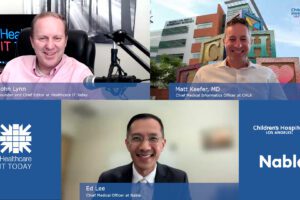A recent study was just published in the BMJ Open journal by lead author Vincent Liu, MD, MS, a research scientist with the Kaiser Permanente Division of Research. The whole study is a fascinating read, but the basics of the study was trying to predict COIVD-19 surges before they happened. They developed CHOTS (COVID-19 HotSpotting Score) to increase the lead time to as much as 6 weeks before COVID-19 surged versus the individual indicators that only provided 1-3 weeks lead time.
Here’s what’s included in the CHOTS score:
CHOTS includes 4 major variables — cough and cold calls, relevant subject headers from patient emails, positive COVID-19 test rates, and current COVID-19 hospital census — along with 6 minor variables, including COVID-19-related calls to the call center, both routine and urgent clinic visits for respiratory infections, clinic and urgent clinic COVID-19 visits, and respiratory virus tests ordered.
You can see how many of these data elements were easily available in Kaiser’s Epic EHR. However, a few of them stood out to me when I first read it. Things like calls to the call center and secure emails aren’t often available in the EHR or in any system a healthcare organization may have in place. Or at least that data isn’t in a format that can be easily combined with EHR data to replicate this score. Of course, Kaiser is unique in that they have all of this data available to them in Epic.
Turns out, the researchers understood this and found that a similar simplified tool without these indicators also showed a “strong, but modestly lower, correlation.” Plus, they also looked into using more advanced tools like machine learning and artificial intelligence that they use in their other research. However, they found that these more advanced efforts didn’t improve the tool’s value. So, they stuck with the simpler tool that could more easily be implemented and shared with other organizations (the tool is freely available for others to use).
What’s impressive was how much data researchers had available to them to do this study. Kaiser Permanente Northern California (KPNC) serves 4.5 million members across 21 hospitals and >250 medical offices and the study used over 35 million data points including the following:
The highest count totals were seen for indicators available retrospectively from January 2015 through September 2020 including respiratory infection clinic visits (n=9 459 882) and ED encounters (n=7 423 168). Among COVID-19-relevant predictors available from 1 March 2020 forward, the most common included COVID-19 tests ordered (n=936 360) and COVID-19-related call centre calls (n=531 765).
Another great finding in their research was that the CHOTS tool was effective with individual medical centers and regionally. They do warn that “Continuously changing routine healthcare practices and patterns attributable to COVID-19 will require ongoing score re-examination and the potential use of other statistical approaches for refinement.” Not to mention large-scale vaccination efforts and treatments may impact performance of CHOTS. Plus, this tool doesn’t try to predict the precise COVID-19 hospital census.
While this tool can’t predict the hospital census, the larger lead time for predicting a COVID-19 surge provides a larger window to be able to more effectively mitigate a surge or to adequately prepare hospitals and public health agencies for the surge. Hospitals can ensure they have additional staff, supplies, and space needed to care for large numbers of patients in advance of the expected need. Public health officials can also use this to better implement policies and messaging earlier than they can with current or lagging COVID-19 activity.
As cases are starting to surge in many parts of the country, it’s great to have researched studies like this coming out to help healthcare organizations and public health officials better predict surges. I’ll be interested to see if this study is generalizable across other geographies since this was done in Northern California. Plus, there’s an important lesson here when it comes to the value of having access to data like call center calls and emails that I think many wouldn’t have thought that important clinically.













